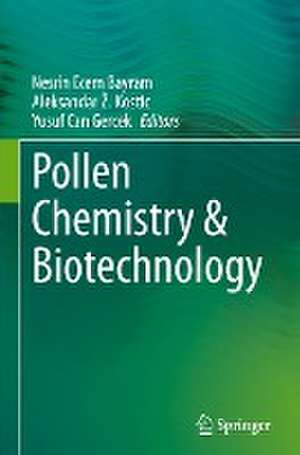Pollen Chemistry & Biotechnology
Editat de Nesrin Ecem Bayram, Aleksandar Ž. Kostic, Yusuf Can Gerceken Limba Engleză Hardback – 18 ian 2024
Pollen Chemistry & Biotechnology summarizes current knowledge of the chemical composition of pollen, its importance as a functional food ingredient and its health promoting properties. As Introduction part a short elaborate about botanical characteristics and data, including morphology and anatomy of pollen and bee preferences, is given. Important factors such as the botanical and geographical origin, best practices for preservation of nutritional composition, bioactivity and safety of pollen are covered in full. The nutritional profile of pollen based on data for minerals, lipids and nutrients is presented. A detailed phytochemical profile of pollen based on data for phenolics, flavonoids, carotenoids, vitamins, bioactive compounds is also covered. Areas for the improvement of the bioavailability of different nutrients and bioactive compounds of pollen via applied pretreatments are presented, as are best practices for adequate pollen collection, procession and storage in order to obtain safe products. At the end, an overview about pollen bioactivity as reason to use it as source of pharmaceuticals is made.
Preț: 1007.49 lei
Preț vechi: 1228.65 lei
-18% Nou
Puncte Express: 1511
Preț estimativ în valută:
192.79€ • 206.15$ • 160.74£
192.79€ • 206.15$ • 160.74£
Carte tipărită la comandă
Livrare economică 18 aprilie-02 mai
Preluare comenzi: 021 569.72.76
Specificații
ISBN-13: 9783031475627
ISBN-10: 3031475623
Pagini: 339
Ilustrații: VIII, 339 p. 37 illus., 27 illus. in color.
Dimensiuni: 155 x 235 mm
Greutate: 0.66 kg
Ediția:1st ed. 2023
Editura: Springer International Publishing
Colecția Springer
Locul publicării:Cham, Switzerland
ISBN-10: 3031475623
Pagini: 339
Ilustrații: VIII, 339 p. 37 illus., 27 illus. in color.
Dimensiuni: 155 x 235 mm
Greutate: 0.66 kg
Ediția:1st ed. 2023
Editura: Springer International Publishing
Colecția Springer
Locul publicării:Cham, Switzerland
Cuprins
Pollen morphology and anatomy with botanical preferences made by bees: an introduction data.- Amino acids, peptides, and proteins of pollen.- Bee pollen carbohydrates composition and functionality.- Lipids in pollen.- Macro-, micro-, trace, and toxic elements of pollen.- Phenolic acids in pollen.- Flavonoids in Pollen.- Carotenoids and vitamins of pollen.- Important contaminants (mycotoxins, pesticide residues, pirolizidine alkaloids) in pollen.- Other bioactive constituents of pollen.- Microbiology of pollen.- Physical and bioprocessing techniques for improving nutritional, microbiological, and functional quality of bee pollen.- Good practice of pollen collection-what pollen traps are better choice.- Techno-functional properties of pollen.- Bee Pollen as a Source of Pharmaceuticals: Where Are We Now?
Notă biografică
Nesrin Ecem Bayram is an Associate Professor at Bayburt University, Aydıntepe Vocational College, Department of Food Processing in Bayburt, Turkey, ecem.nesrin@gmail.com; nesrinbayram@bayburt.ed.tr
Aleksandar Ž. Kostić is an Assistant Professor at the University of Belgrade, Faculty of Agriculture, Chair of Chemistry and Biochemistry in Belgrade, Serbia, , akostic@agrif.bg.ac.rs
Yusuf Can Gercek is an Assistant Professor at Istanbul University in the Faculty of Science, Department of Biology in Istanbul, Turkey, yusuf.gercek@istanbul.edu.tr
Aleksandar Ž. Kostić is an Assistant Professor at the University of Belgrade, Faculty of Agriculture, Chair of Chemistry and Biochemistry in Belgrade, Serbia, , akostic@agrif.bg.ac.rs
Yusuf Can Gercek is an Assistant Professor at Istanbul University in the Faculty of Science, Department of Biology in Istanbul, Turkey, yusuf.gercek@istanbul.edu.tr
Textul de pe ultima copertă
Pollen is made up of many chemical constituents such as proteins, sugars, lipids, minerals and phytochemicals. These components make pollen products an excellent source of nutrients and antioxidants for consumers. However, mycotoxigenic fungi are also common in pollen, creating contamination from generated mycotoxins. With adequate monitoring, sampling, processing and storage of pollen the development of mycotoxins can be significantly prevented. Since pollen grain has strong membranes which can limit the bioavailability of some nutrients and phytochemicals, novel methods and pretreatments are required with special emphasis on microbiological pretreatment methodologies.
Pollen Chemistry & Biotechnology summarizes current knowledge of the chemical composition of pollen, its importance as a functional food ingredient and its health promoting properties. As Introduction part a short elaborate about botanical characteristics and data, including morphology and anatomy of pollen and bee preferences, is given. Important factors such as the botanical and geographical origin, best practices for preservation of nutritional composition, bioactivity and safety of pollen are covered in full. The nutritional profile of pollen based on data for minerals, lipids and nutrients is presented. A detailed phytochemical profile of pollen based on data for phenolics, flavonoids, carotenoids, vitamins, bioactive compounds is also covered. Areas for the improvement of the bioavailability of different nutrients and bioactive compounds of pollen via applied pretreatments are presented, as are best practices for adequate pollen collection, procession and storage in order to obtain safe products. At the end, an overview about pollen bioactivity as reason to use it as source of pharmaceuticals is made.
Pollen Chemistry & Biotechnology summarizes current knowledge of the chemical composition of pollen, its importance as a functional food ingredient and its health promoting properties. As Introduction part a short elaborate about botanical characteristics and data, including morphology and anatomy of pollen and bee preferences, is given. Important factors such as the botanical and geographical origin, best practices for preservation of nutritional composition, bioactivity and safety of pollen are covered in full. The nutritional profile of pollen based on data for minerals, lipids and nutrients is presented. A detailed phytochemical profile of pollen based on data for phenolics, flavonoids, carotenoids, vitamins, bioactive compounds is also covered. Areas for the improvement of the bioavailability of different nutrients and bioactive compounds of pollen via applied pretreatments are presented, as are best practices for adequate pollen collection, procession and storage in order to obtain safe products. At the end, an overview about pollen bioactivity as reason to use it as source of pharmaceuticals is made.
Caracteristici
Summarizes current knowledge of the chemical composition of pollen Important factors such as the botanical and geographical origin The nutritional profile of pollen based on data for minerals, lipids and nutrients is presented
